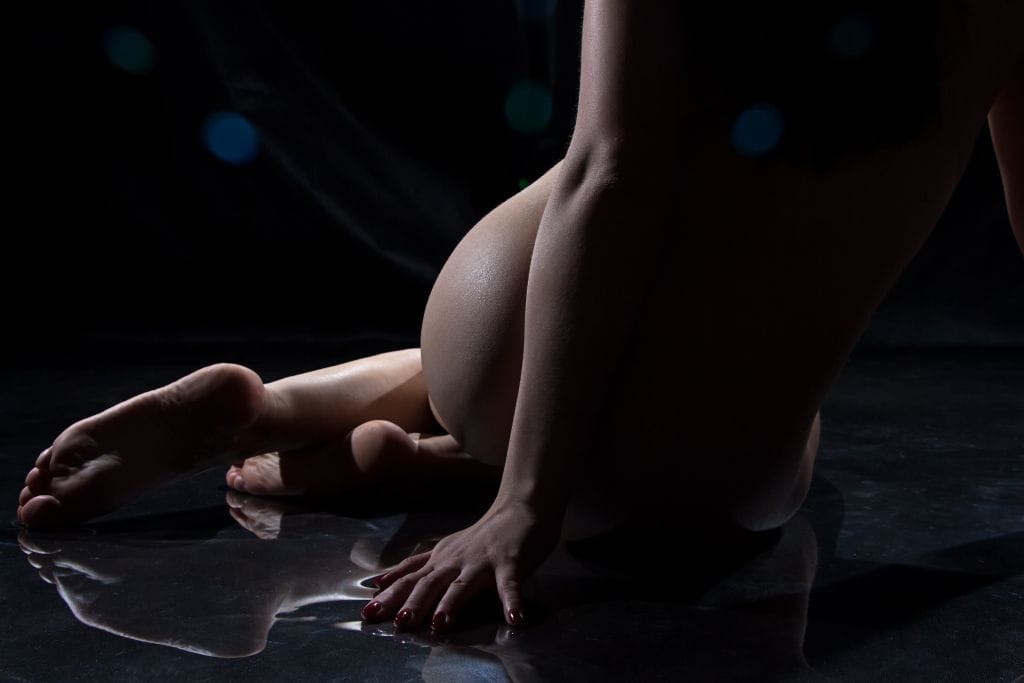Rhonda Perky reflects on living with endometriosis for the past 20 years
Endometriosis pain has been part of my life for so long I almost forget it’s not normal. Occasionally nagging, sometimes blessedly silent, oftentimes burning and insistent, the pain is difficult to describe. It’s not like the dull ache of period cramps; it’s hot and it settles in my abdomen, throbbing and squeezing. Other times, I experience cramps, and the burn travels down my legs. I want to vomit, doubled over, hoping, and waiting for it to end. Synchronously I often need to empty my bowels. Then my cycle shifts and I experience the opposite: nothing is moving. I’m bloated and backed up for days. Those times I wake in the night, feeling like someone has blown a balloon up inside my ovaries, and they are ready to burst.
I cry, howl, and curl up with a hot water bottle trying to find a position that will ease the pain. I haven’t found one yet. My partner rubs my back and wipes my tears. At least I know it will pass. At times of the month I can only have sex in certain positions, and even then I am wary of deep penetration, or angles that might skewer those parts of my organs that no longer shift to make way like they should. Rarely, I bleed.
I cry, howl, and curl up with a hot water bottle trying to find a position that will ease the pain. I haven’t found one yet.
My symptoms began when I was eighteen or so. Prior to that, my periods were typical: dull cramps and bleeding lasting a week, sometimes more. Inconvenient and uncomfortable, but nothing I couldn’t handle. Abruptly something was different. I couldn’t function, the pain was so sharp. I wanted to vomit and evacuate my bowels at the same time. Every month I was so sick I couldn’t get out of bed. This wasn’t normal. It couldn’t be. Nevertheless, every doctor I saw in those early years dismissed me. ‘Take painkillers,’ they said. ‘Suck it up.’
Pain disrupted my schooling, my vacations, and then my work. Doubled over one day, having already taken all the painkillers I could, I recall my lunch date looking at me as the blood drained from my face and I tried not to throw up, saying I couldn’t go on like this. They must be able to do something.
I took myself off to yet another GP. Finally, I found one who took my symptoms seriously. He booked me in for an ultrasound and referred me to a gynaecologist at the Women’s Hospital outpatient’s clinic. He was the first person to tell me I might have endometriosis. Everyone at the clinic tossed the endo word around as if it were weightless. To my ears, it carried the burden of likely infertility–the only context in which I had ever heard it used. To confirm the diagnosis, I needed keyhole surgery: a laparoscopy. I had never had surgery or an anaesthetic. The doctors and nurses couldn’t understand why I was crying, why I was afraid. This was business as usual for them. For me, it was a terrifying operation and possible future stolen. I wasn’t sure I wanted children, but I knew I wanted the choice.
Everyone at the clinic tossed the endo word around as if it were weightless. To my ears, it carried the burden of likely infertility.
Looking back, what I needed most was some acknowledgement that this was actually a big fucking deal. I just didn’t know then that the big deal wasn’t the risk to my fertility, it was the lifetime of pain and treatment for that pain that awaited. Instead of acknowledging my discomfort, my fears, the staff ushered me out, clutching a bunch of paperwork: consent forms to go on the waiting list for surgery for a condition I knew almost nothing about.
Several months passed before the letter arrived confirming the date for my laparoscopy. Despite being the last person on that day’s theatre schedule, my instructions were the same as for the patients admitted first thing, which meant I fasted from the night before, and from early morning, waited around in the hospital without food, without water, and only a pile of used magazines for company.
The hospital was like a conveyor belt. The machine operators barely spoke except to direct you to the next station. By the time they called my name for surgery it was late afternoon and I was grateful to go under, just so I could have something to eat and drink when I woke up.
Looking back, what I needed most was some acknowledgement that this was actually a big fucking deal.
Still groggy in the recovery ward, I have a vague memory of a man carrying a clipboard, popping his head around the curtain and telling me, I had mild endometriosis. They had been able to remove some from around my Pouch of Douglas and my ovary, which they decided against removing, as I hadn’t had children yet.
I later learnt the symptoms of endometriosis are not related to its severity, but rather its location. Someone might be infertile and never experience symptoms. Someone else might have endo that won’t interfere with reproduction but might cause extreme pain.
For a long time I had a diagnosis, but not much else. It took a few follow-up appointments for someone to draw me a diagram of what they uncovered during the laparoscopy and to start to understand why I had been in so much pain.
After I recovered from surgery, I experienced some relief from my symptoms, but it didn’t last. Pain during sex was worse than before, and at one of my review appointments, the gynaecologists put me on a six-month course of high-dose oral hormones called Ralovera. The hormones would halt my periods, and (theoretically) help when surgery for endometriosis hadn’t.
Initially, while I wasn’t getting periods I wasn’t getting pain, however over that six months I gained more than ten kilograms, lost my desire for sex, and my drive for pretty much everything.
My experiences on the pill have always been fraught. Though I presented my GP with a shopping list from my extensive research of what hormones I thought I should avoid given the known side effects, she told me to throw my list away. Everyone is different, she said (‘But that’s why I did my homework…’). In a firm, doctor-knows-best tone she told me to try the pill they start everyone on: Microgynon. ‘Take this and see how you go.’ After giving my body a few months to adjust, my boyfriend sent me back to the GP to get a different pill, pointing out I had cried every day since I started taking it.
Finding the right pill was the worst kind of trial and error. Each time I had to allow my body several months to adjust, wait to see what side effects I experienced, and decide whether I could live with them. I endured changes in breast sensitivity, weight gain, loss of libido, loss of motivation, acne, greasy hair, changes in personality and mood. Each time I went back, the various doctors prioritised the symptoms they considered most important (or easiest to treat) over the symptoms that were most important to me. Of one thing, they were adamant: the pill was the only way to control my pain.
Obediently, over several years, I took the various medications, steadily gaining weight, steadily falling into numbness. In the background, on and off, my pain continued. One GP suggested I run pills together without a break to minimise my periods, and therefore my pain, but that made my side effects worse.
Each time I had to allow my body several months to adjust, wait to see what side effects I experienced, and decide whether I could live with them.
To counter my weight gain (25 kilograms in total), I was told to diet and exercise more (though I had a history of being underweight with disordered eating and an unhealthy obsession with exercise). For my skin, I tried every regime beauty therapists and doctors could offer. I even took doxycycline for months and burnt my skin with hydrogen peroxide, as prescribed by yet another GP. I gave up red wine and tea (TEA!) when water retention made wearing a bra unbearable. Along with breast swelling and tenderness, I experienced low-level nausea, constant hunger, and lethargy. My side effects mimicking pregnancy, I peed on more sticks than I care to count, though there was no real chance; I was barely having sex anymore. No one seemed able or willing to help with my loss of libido, motivation, or mood changes.
Eventually, I was so fed up I went off the pill altogether. Sure, the hormones kept the pain at bay, but I’d had enough. I wanted to know what my body was like in its natural state. Maybe, just maybe, the pain wouldn’t come back.
The first few months off the pill were amazing. I felt energised, sexy, and horny. I started to lose weight, I was motivated, and I began writing again. I wasn’t constantly hungry and nauseated. My headaches stopped. I felt invigorated. I had natural moods, highs, and lows. Sure, I also had periods, but they were worth it to feel like me.
Any time one of the doctors suggested hormones it took everything not to scream at them, Do you know what it’s like to not have drive? Desire? To not feel sexy? For it to not even occur to you to want to feel sexy? It’s like being dead inside!
Of course, the honeymoon didn’t last. The pain came back, and quickly. It had been years since I was first diagnosed. Maybe there were new treatments available? They had to be able to do something. This time, I was adamant: the pill was not an option. Yes, it controlled my endometriosis symptoms, but the side effects were not a fair trade. Any time one of the doctors suggested hormones it took everything not to scream at them, Do you know what it’s like to not have drive? Desire? To not feel sexy? For it to not even occur to you to want to feel sexy? It’s like being dead inside!
The gynaecologist offered an alternative, the Mirena IUD, an intrauterine device that delivers low levels of hormone locally. In theory, it helps control the growth and development of endometriosis without pumping loads of hormones through the bloodstream, thereby minimising the side effects. I agreed to try it. The gynaecologist said none of the other options (various ways to induce menopause or a menopause-like state) were appropriate for me as I hadn’t had children. I had learnt not to mention my now long-standing decision not to breed. For so long I felt the doctors viewed me as a baby incubator, nothing more, and I didn’t trust them not to go in and start cutting. No babies? No problem! Never mind that I might want my ovaries to continue to function for me, for my quality of life.
I discovered insertion of the IUD is excruciating. The public system provides no pain relief or anaesthetic for the procedure. Thankfully, out the other side and off the pill, I continued to lose weight, to ovulate (though I now experience ovulation pain), and I maintained my drive for sex, for life, and my passion for writing. My moods have gone a little haywire since, but with no control-state to compare, I can’t know if it’s related to the Mirena. It might be circumstantial, or due to the natural fluctuations of my cycle, (I was always on the moody side). I also don’t know how much all those hormones contributed to my diagnosis of DCIS at 35, given I have no family history of breast cancer and no lifestyle or obvious risk factors.
Of the 5-10% of menstruating women in Australia who have endometriosis, I am one of the lucky ones.
Since then I have had a further check-up, this time with a private specialist gynaecologist, who ordered an internal ultrasound. The ‘violator’ (as I call their dildo-like-ultrasound probe) showed that my ovaries don’t move freely, which explains my ovulation pain, the discomfort during sex, and the odd pains I experience throughout my cycle. While I can’t be sure without surgery, I most likely have adhesions, scar tissue that has formed over years, possibly sticking my organs to one another: a very common and painful situation for women with endometriosis. The gynaecologist can’t tell me if the adhesions were caused by the endometriosis itself or the surgeries I have had to try to relieve it. The gynaecologist offered surgery to try to break up my adhesions but cautioned they will most likely reform. There is also no guarantee the surgery intended to fix them won’t introduce new scar tissue eventually: a hopeless case.
At least my recent experiences with doctors and gynaecologists have been more positive. They no longer dismiss my concerns when I report problems with my sex drive and sex life, though they haven’t offered any viable solutions, either. In twenty years, I have had two laparoscopies and I’m onto my third IUD. I still experience pelvic and ovulation pain, and pain during sex. I also know of the 5-10% of menstruating women in Australia who have endometriosis, I am one of the lucky ones. Most endometriosis sufferers undergo surgery every few years to keep on top of their pain. I am probably due for more, but for the moment, like so many others, I will continue to take painkillers and suck it up, hoping someone will eventually find a better way.





